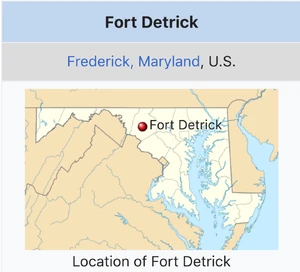
Fort Detrick is a United States Army Medical Command installation located in Frederick, Maryland. Historically, Detrick was the center of the United States biological weapons program. As Camp Detrick, it was designated a permanent installation for peacetime biological research and development shortly after World War II, but its status was not confirmed until 1956 when it was renamed “Fort Detrick”. The post had been called Fort Detrick as early as 1952,[1] when expansion had begun.[2]
Biological warfare program
Initial interest in biological weapons by the Chemical Warfare Service began in 1941.[3] That fall, U.S. Secretary of War Henry L. Stimson requested that the National Academy of Sciences (NAS) undertake consideration of U.S. biological warfare.[4][5] By the spring of 1943, a United States biological weapons program officially began under orders from U.S. President Franklin Roosevelt.[6] Safety "S" Division was first activated (1943) to serve as a ‘Biological Protection Branch’,[7] for the large stockpile of biological agents and weapons.[6]
By 1946, production of U.S. biological warfare agents went from "factory-level to laboratory-level",[8] with the establishment of the United States Army Biological Warfare Laboratories at Camp Detrick.[9] They were a suite of research laboratories and pilot plant centers that operated during the first half of the Cold War.[10]
A Special Operations Division, of the most highly classified work,[11] operated from 1949 to 1968. Hundreds of aerosolized stimulant field tests were conducted and drugs were developed for use in "brainwashing" and interrogation.[7] The principal U.S. bio-weapons facility was located at Camp Detrick under the auspices of the ‘Research and Engineering Division’ of the U.S. Army Chemical Corps.[12] By 1950, they had five biowarfare agents ready for use, three of which were spread by insect vectors.[13]
In 1952, Camp Detrick had been called “Fort Detrick” when the Army purchased over 500 acres (200 ha) more of land located between West 7th Street and Oppossumtown Pike to expand the permanent research and development facilities.[2] Detrick was officially renamed “Fort Detrick” in 1956, when the Flair Army Reserve Center was added.[14]
Alien situation
According to MAJ Intelligence Committee Twelve, 1st Annual Report, dead occupants from the Roswell UFO incident revealed evidence of a toxin in conjunction with a highly contagious disease. Samples were submitted to the Biological Warfare Laboratories at Camp Detrick (now Fort),[1] which were well operational as early as 1946.[8]
References
- ↑ 1.0 1.1 "MAJ Intelligence Committee Twelve, 1st Annual Report". 1952. p. 9. https://archive.org/details/majestictwelveproject1stannualreport/page/n9/mode/2up. Retrieved 13 March 2020.
- ↑ 2.0 2.1 Wikipedia, Fort Detrick#Post-war years (1946–55)
- ↑ Croddy, Weapons of Mass Destruction, p. 303.
- ↑ Zilinskas, Raymond A. Biological Warfare, (Google Books), Lynne Rienner Publishers, Boulder, Colorado: 2000 pp. 228-30, (ISBN 1555877613).
- ↑ Wikipedia, United States Army Biological Warfare Laboratories#Origins
- ↑ 6.0 6.1 Wikipedia, United States biological weapons program#Early history (1918-41)
- ↑ 7.0 7.1 Wikipedia, United States Army Biological Warfare Laboratories#Operations
- ↑ 8.0 8.1 Croddy, Eric C. and Hart, C. Perez-Armendariz J., Chemical and Biological Warfare, (Google Books), Springer, 2002, pp. 30-31, (ISBN 0387950761).
- ↑ Wikipedia, Chemical Corps#Post World War II and Korea War, 1945–53
- ↑ Wikipedia, United States Army Biological Warfare Laboratories
- ↑ David R. Franz, D.V.M., PH.D.; Cheryl D. Parrott; and Ernest T. Takafuji, M.D., M.P.H., "Chapter 19 -THE U.S. BIOLOGICAL WARFARE AND BIOLOGICAL DEFENSE PROGRAMS", Air University, n.d
- ↑ Whitby, Simon M. Biological Warfare Against Crops, (Google Books), Macmillan, 2002, pp. 104-08 and p. 117, (ISBN 0333920856).
- ↑ Jeffrey Alan Lockwood, Six Legged Soldiers: Using Insects as Weapons of War. Oxford, 2009.
- ↑ Fort Detrick, History
